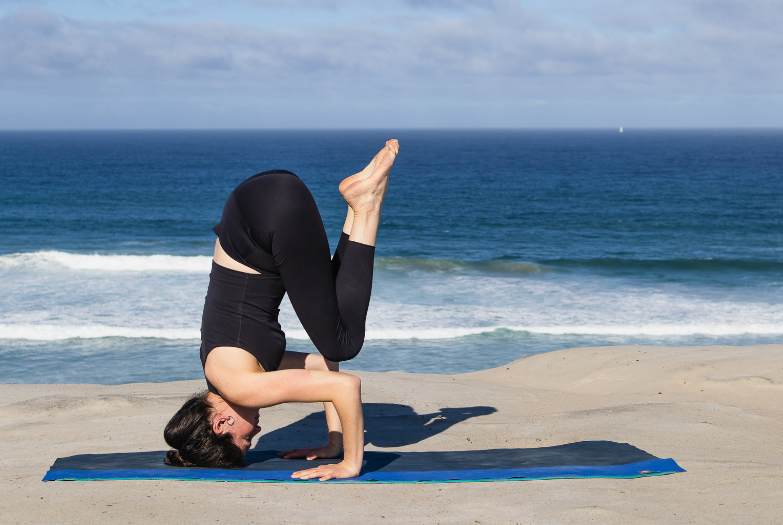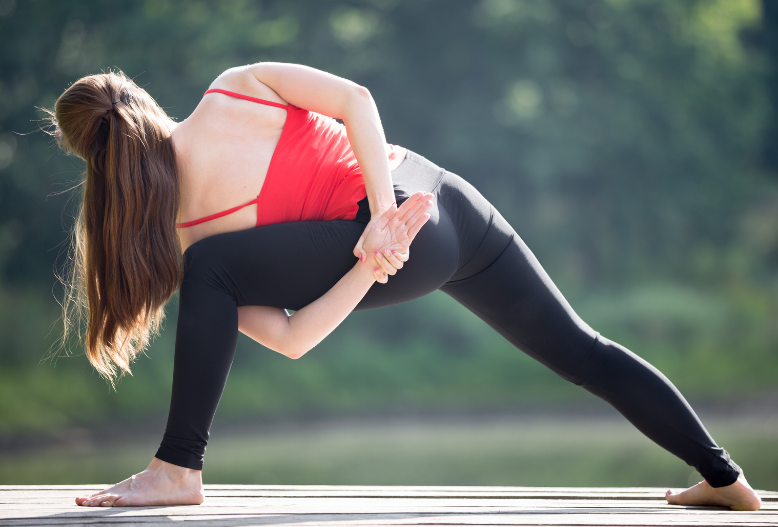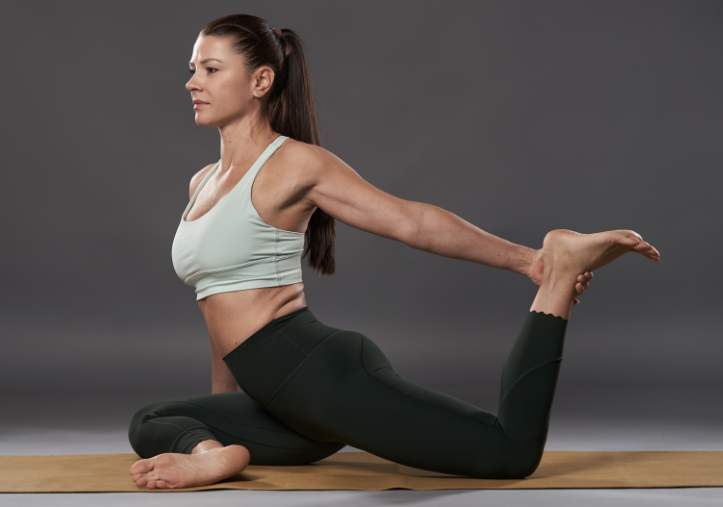
15 Examples of Yoga Poses to Avoid During Pregnancy
What? Are there really 15 yoga poses to avoid during pregnancy?
Well sort of. Most of these poses can be modified.
If you do a quick search you will see all sorts of yoga poses to avoid during pregnancy. From happy baby to down dog and handstand. In truth most of these are unfounded. This list will be a more practical guide and I hope provide you some reassurance.
This list contains 13 asanas or poses and 2 breathing techniques or pranayama. We will dive in a bit deeper to see what really needs to be avoided vs what you can play around with. Many of these are more advanced so if they were not in your practice before hand, leave them out.

Can you safely practice yoga while pregnant?
Yes!
As long as you are not restricted from exercising by you physician. Yoga can provide a number of physical and mental benefits to support your pregnancy. From decreased stress and improved quality of life to possibly improved labor.
Yoga poses to avoid during pregnancy
Revolved side angle
Revolved triangle
Adding binds to revolved poses
Full wheel
Headstand
Twisted chair
Boat
Full Camel
Jump-backs
King Pigeon
Full dancer
Chin stand
Yoganidrasana or feet behind head pose
Yoga Breathing to avoid during pregnancy
Breathe retention
Breathe of fire
Let’s take a closer look at which yoga poses to avoid during pregnancy and which to modify

Revolved Side Angle
This pose is one you will be forced to avoid as your growing belly gets in the way. Stick to your traditional side angle.
Revolved Triangle
This pose you can modify through most of your pregnancy. Keep your rotation more open with your hand inside the foot rather then the outside. The larger the space between hand and foot the more open you will be.
Use blocks here or better yet a chair to support your hand. Focus on keeping bellybutton pointing down and work slight rotation in your thoracic spine.
Full wheel yoga pose to avoid during pregnancy
Skip this one and stick to an engaged bridge pose. Full wheel can cause strain on the linea alba (the fiberous conective tissue that runs down the center of your abdomen) and lead to or worsen diastasis recti (the separation of your abdominal muscles)
Another yoga pose to avoid during pregnancy is headstand
This is a yoga pose to avoid during pregnancy. If you check out instagram you will see plenty of pregnant yogis still performing this pose. While inversions are not off limits this is one I would remove from your practice for a while.
As relaxin increases in your system it will loosen the ligaments in your joints. This usually peaks around 12-14 weeks. This is often before your baby bump would limit you.
The risk of straining your neck is just not worth it.
Twisted chair
You can continue to perform twisted chair early in your pregnancy but you want to be mindful of how deep you are going. You should not feel any abdominal discomfort.
As your pregnancy progresses you will need to start opening up your twist until you are avoiding twisted chair all together and practicing only chair pose.
Modify your boat pose
While you should avoid V-up sit ups, going supine to boat, you can modify your boat pose. Perform on an incline using a bolster and blocks. You can also support your self with your hands and lifting only one leg at a time.
You want to make sure that your pelvic floor and lower abdominals are engaged. If you notice any belly bulging or doming discontinue. This is a sign your abdominals are separating.
Full Camel
If full camel was easy for you to obtain prior to pregnancy you will likely be able to continue with the full expression a bit longer. You want to make sure you keep your abdominals engaged and avoid any bulging.
To modify simply use blocks at whatever height you need. Place the blocks on the outside of your heels and reach hands towards blocks rather than heels.
Jump back transitions may need to be avoidecd
This one is going to depend on your level of practice. If you are newer to yoga you will want to avoid jump backs and simply perform more controlled step back transitions to protect your joints.
If you have been practicing jump backs for a while and are able to perform smoothly and easily you can practice them during practice. You may want to avoid around weeks 10-17 when relaxin is peaking and again in your 3rd trimester for comfort and decreased strain on your joints.
King Pigeon is a yoga pose to avoid during pregnancy
You can still continue very early in pregnancy if this pose came easily to you before hand but once relaxin starts to peak you will want to avoid it. King pigeon should be avoided regardless of it is performed one leg or two
Other then the extreme flexibility needed for your foot to reach your head. Full king pigeon is prone making it uncomfortable and difficult as you start showing. Stick to traditional pigeon during pregnancy.

Modify Full Dancer
Don’t strive for toes to head in full dancer to avoid pushing the limits of your flexibility and to decrease risks of abdominal separation. Keep your dancer more open and use a strap as needed.
Another yoga pose to avoid during pregnancy is chin stand
Even if this pose was regularly in your practice pre pregnancy it should be avoided during pregnancy. Due to relaxin loosening your joints and the risk of strain on your neck leave this out.
Modify Yoganidrasana
Instead of continuing to practice to get your foot behind your head you can modify by keeping foot to elbow. You will still achieve the same benefits of the pose while focusing more on stability and less on gaining flexibility.
Avoid breath retention and breath of fire
You want to keep your breath full and easy during pregnancy. Shortness of breath is a common complain and you don’t want to exaggerate it. Breath retention (holding your inhale and or exhale) and breath of fire (active quick exhales in succession followed by passive inhales) can lead to feelings of dizziness or breathless.
You will want to focus on mindful breathing with use of your diaphragm with goals of relaxation which may prove useful while in labor.
Any yoga poses to avoid in your first trimester of pregnancy?
In general most of the poses recommended to avoid or needing modifications come later on in pregnancy as you start to show. You do want to be mindful of pushing into your flexibility in your first trimester as that is when Relaxin peaks.
So to review headstands, chin stands are out and poses that push your flexibility need to be modified during your first trimester.
In general you want to focus on strength and balance in your first trimester. Chair pose, tree pose, lunge poses are all great options.
You will also want to avoid heated practices in your first trimester.
Are there particular types of yoga to avoid during pregnancy
While yoga is generally safe and beneficial during pregnancy there are a few types of practices you will want to avoid. Those are hot yoga, Bikram yoga and Yin yoga.
During your pregnancy you should avoid working out in hot and humid conditions because you need to avoid getting your core temperature above 102 degrees F. Hot yoga rooms and Bikram yoga rooms are just too hot for now.
I would suggest avoiding Yin yoga as well because although relaxing the main focus on yin yoga is to increase flexibility. During pregnancy, when joints are generally looser you actually want to focus on strength and stability over pushing your flexibility limits.
OK so you made the modifications. When can you return to your normal practice?
Generally you will be asked not to resume working out until after your 6 week check up. This will of course depend on type of delivery you had as cesareans may require more time.
Although returning to working out should be avoid you don’t want to avoid movement all together. Walking and gentle seated postures are generally safe to resume right away. You can also immediately resume any breath work you did pre pregnancy after delivery.
After your 6 weeks you can resume most yoga practices. For more vigorous or power classes you may want to wait closer to 10-12 weeks to allow for gradual build up of strength needed for these practices.
Do not hesitate to reach out to your physician or physical therapist with questions regarding not only safe but affective returns to practices.
Thank you for sharing!
Struggling with postpartum pelvic pain, leaks, or discomfort? Download your FREE Postpartum Pelvic Recovery Guide and learn simple, expert-backed strategies to heal, strengthen, and feel like yourself again. Because your recovery matters—let’s take care down there!
